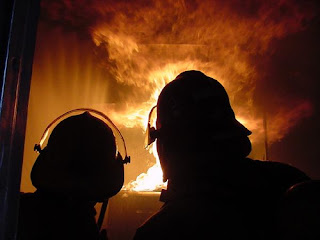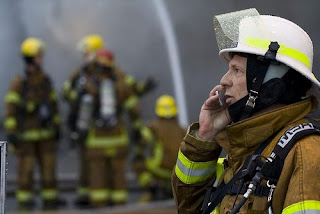 “Firefighters must be warned of the extreme dangers associated with enclosed structures,” says San Antonio’s Captain Mora. “(They) must be informed that (waging) an aggressive attack immediately on arrival may be ineffective and unsafe in many cases.”
“Firefighters must be warned of the extreme dangers associated with enclosed structures,” says San Antonio’s Captain Mora. “(They) must be informed that (waging) an aggressive attack immediately on arrival may be ineffective and unsafe in many cases.”
Disorientation and the Interior Firefight
During a recent Delaware incident, 7 firefighters became trapped on a 2nd floor duplex during a tough firefight. Fortunately, the firefighters were rescued by an agressive Rapid Intervention Team with just minutes to spare. Initial reports were that there was no life hazard, as occupants had been accounted for. But considering the time of day, 7:30am on a Saturday morning, Chief Chuck Hayes did what most chief officers would do -- order a search.
 “Firefighters must be warned of the extreme dangers associated with enclosed structures,” says San Antonio’s Captain Mora. “(They) must be informed that (waging) an aggressive attack immediately on arrival may be ineffective and unsafe in many cases.”
“Firefighters must be warned of the extreme dangers associated with enclosed structures,” says San Antonio’s Captain Mora. “(They) must be informed that (waging) an aggressive attack immediately on arrival may be ineffective and unsafe in many cases.”
Several folks have asked me to repost this 2006 feature dealing with Disorientation and the Interior Firefight as it closely resembles the Delaware incident. LPA
---
(Anytown, USA) -- The fire service here in the USA is extremely fortunate to employ some of the bravest firefighters and most knowledgeable fire officers in the world. But firefighting is inherently a dangerous profession, and things will and do go wroong. When a firefighter loses his or her life in a burning structure it is usually a result of unanticipated or unexpected fire development, not the inadequacies of command or even a firefighter’s skills.
So what’s the problem and how do we fix it? Back in the mid 70's, the fire service modified its approach to firefighting from surround and drown -- to one of adopting an aggressive interior fire attack. This tactic requires that firefighting teams make their way inside the burning structure and remain there under even the most severe conditions. Over the past few years the procedure has become the source of heated debate among instructors and officers because the interior attack assumes that there are victims inside the burning building who need to be rescued.
Since the introduction of superior protective gear (Nomex and PBI) in the late 70’s, virtually every fire-training instructor nationwide has taught their students to conduct an extremely aggressive interior attack, sometimes referred to in the books as Offensive Strategy. The idea is to take an pro-active stance, moving nozzles and hoselines deep inside a building to meet the fire monster on its own turf.
But my personal belief is that -- unless a life safety issue exists -- firefighters should never attempt to inhabit the same space as fire. Being there is a lot like snorkeling in shark-infested waters, then poking a Great White in the eye.
Inadequate Staffing
According to a report issued by Captain William R. Mora of the San Antonio Fire Department, many firefighters (often Truck company members) choose to begin search and rescue operations without the assistance of an Engine company and their hoseline. "It's in our blood to rush in." one rookie told me. "Try keeping me out!"
Unfortunately, in far too many situations, the search begins prematurely because of poor staffing (career) and lack of responders (volunteers). The obvious concern in these situations is that teams that have entered won’t have the extinguishing tools to cool a blaze should flashover rear its ugly head. (Ever wonder why FDNY has a "can man.") And with no hose (or lifeline rope) to follow back to safety, firefighters often have no way out!
When the search and rescue effort goes south, a firefighter can easily become disoriented and lost in the blaze. Without a buddy by his or her side, they face the unknown alone. Panic sets in and it’s just a matter of time before they breathe-out their bottle, collapse and succumb to the blaze.
“The root of the disorientation problem in the fire service,’ the San Antonio study reads, ‘is the lack of knowledge about the extreme danger posed by enclosed structures and the disorientation sequence.”
In many communities, especially those protected by volunteer companies, firefighters sometimes ignore the important fact that fighting a structural blaze is a team effort. Rather than wait for next arriving units, the few who have assembled on the fireground often begin search and rescue -- or the hoseline advance -- lacking appropriate support and resources.
Crucial to fire extinguishment is proper vertical ventilation, which we’ve all been taught should take place simultaneously with the hoseline attack below. However, before the chain saw is on the roof, well-meaning hose teams – working alone -- may quickly find the seat of the fire and bravely open the nozzle to dampen the blaze. But with no vent opening to release smoke and hot gases, the team destroys the delicate thermal balance, allowing super-heated air from above to drop down to the floor and bake them like lobsters.
In cases like this, inexperienced firefighters may panic and abandon the line, leaving their partner behind. The team is now separated, company integrity is lost, and it can only go downhill from here. Call in the FAST team!
 “Firefighters must be warned of the extreme dangers associated with enclosed structures,” says San Antonio’s Captain Mora. “(They) must be informed that (waging) an aggressive attack immediately on arrival may be ineffective and unsafe in many cases.”
“Firefighters must be warned of the extreme dangers associated with enclosed structures,” says San Antonio’s Captain Mora. “(They) must be informed that (waging) an aggressive attack immediately on arrival may be ineffective and unsafe in many cases.”
Life Safety Issue
There’s no denying that firefighters must enter flaming structures to conduct search and rescue operations, especially when civilians are reported trapped, or the commanding officer feels that an interior attack is warranted. However, changing the behavior of two generations of firefighters, who have had the term “aggressive interior attack” drilled into their helmets, will be a tough assignment for company officers and training personnel. But change is coming slowly and some forward thinking administrators have begun to embrace alternate tactics, like large line blitz attacks using portable master stream devices.
A reminder: We’re told that the most important tactic in any type of firefight is size-up. So, the next time your company pulls up in front of a burning building, quickly establish command and learn as much about the situation at hand as you can. If there is no life-safety issue and no danger to surrounding structures, hold back the hoseteam, by their SCBA straps if you must. Wait for second due companies to arrive, then engage in a coordinated attack.
Like they say, “Everyone goes home!"
------
Resources
Add a Comment
-
Comment by Jeff Betz on January 7, 2008 at 9:27pm
-
Lots of "good stuff" here, thanks for the post. I could elaborate at length about these items, so you did your job and made me think...kudos to you.
-
Comment by Mary Ellen Shea on January 7, 2008 at 3:43pm
-
The battle faced here is that the fire service is populated by "old sea dogs" ...and we all know how tough it can be to teach old dogs new tricks...even if it's to better their safety environment.
Specialty Websites
Find Members Fast
Firefighting Videos
© 2025 Created by Firefighter Nation WebChief.
Powered by
![]()
Badges | Contact Firefighter Nation | Privacy Policy | Terms of Service



You need to be a member of My Firefighter Nation to add comments!
Join My Firefighter Nation